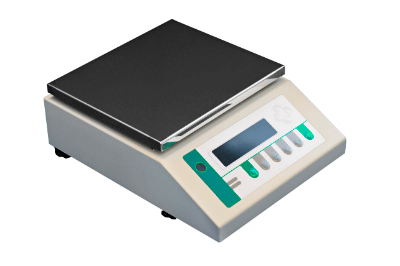What Is an Electronic Scale?

An electronic scale is a weighing instrument used to measure the mass of an object.
The two most common types of electronic scales in general use are the electromagnetic force balance type (electromagnetic type) and the load cell type. Electromagnetic electronic scales use electromagnetic force instead of weights in balances and are characterized by their ability to perform highly accurate measurements. On the other hand, they tend to have complex structures and are difficult to miniaturize.
Load cell electronic scales use electrical resistance instead of electromagnetic force to perform measurements. Since the structure is simpler than that of the electromagnetic force balancing type, it is relatively easy to manufacture large products. On the other hand, they tend to be inferior to the balanced electromagnetic force type in terms of accuracy.
Principles and Uses of Electronic Scales
There are various types of electronic scales with different measurement principles. As mentioned above, the two main types are the electromagnetic balance type and the load cell type.
The electromagnetic force balance type uses electromagnetic force to balance a sample in a receiving pan as a substitute for a weight to measure its weight. A downward force is applied by passing an electric current through a force coil. The balancing is controlled by controlling the current value of the force coil while checking the balancing position with a light source and position sensor. The weight is read by reading the current value at this time.
As mentioned above, the electromagnetic force balancing type electronic scales excel in high-precision measurement. For this reason, they are used in analytical electronic scales (electronic balances) designed for experiments that require high precision. However, it is important to perform calibration as necessary for accurate measurements.
Structure of Electronic Scales
The load cell method reads the weight from the deflection of a strain gauge made of aluminum or other material. Strain gauges attached to the strain body expand and contract, resulting in a change in electrical resistance. The weight is measured by reading this change in resistance as an electrical signal.
Load cell electronic scales are characterized by their simple structure. They are used in large electronic scales such as weight scales and are also used in small scales when cost reduction is desired.
How to Select an Electronic Scale
When selecting an electronic scale, it is necessary to select an appropriate one according to the characteristics of the sample to be measured, the purpose of use, etc. Basically, the size of the weighing pan, weighing capacity, and minimum display should be selected.
First of all, the scale must have a pan that matches the size of the sample to be measured.
The weighing capacity is the maximum amount that the scale can accurately measure. The weight of the object to be measured must be within the scale weight.
The minimum indication is the smallest value that the instrument can indicate in a measurement and should be selected according to how closely the object to be measured is measured. It is important to note that the minimum indication is only the smallest value that can be displayed and does not mean that the sample can be accurately measured to that value. The smallest weight for which an object can be measured accurately is the minimum weighing value, which is the smallest size for which twice the standard deviation of repeated measurements falls within 0.10% with a probability of 95.4%.
If measurement accuracy is important, attention should also be paid to the linearity and repeatability of the instrument. The higher the measurement accuracy, the more expensive the scale will be. Therefore, it is important to select an appropriate scale according to the accuracy you wish to measure.